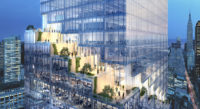The High Line, the Manhattan elevated railway that’s undergoing conversion from industrial artifact to public green space, is the work of a trifecta of design-world giants, including architect Diller Scofidio + Renfro, landscape studio Field Operations, and the lighting design firm L’Observatoire. The park also has cast stylish ripples. Since a June 2005 rezoning, the surrounding neighborhood has boomed with upscale condominiums conceived by Lindy Roy, Della Valle Bernheimer, and Neil Denari [RECORD, June 2006].
Annabelle Selldorf designed 200 Eleventh Avenue, a tower of stainless-steel facades rising from a cast gunmetal–glazed terra cotta base (top left). Jean Nouvel’s 100 11th features a curtain wall assembled of 1,700 panes of glass in a variety of sizes and inserted into steel frames at a series of angles (top right). The 16 units of 200 Eleventh Avenue include elevator-accessible garages integrated with each apartment (middle). Shigeru Ban’s Metal Shutters House features pivoting glass walls and motorized metal shutters that can encase large terraces (above).
Thanks to the local real estate market’s defiance of a downward national trend, developers and architects continue to announce new condo projects that are changing the neighborhood as dramatically as the High Line’s own transformation. Although these buildings are clearly intended for the privileged few, they include features inspired by the future public amenity, such as contextual material choices and fenestration patterns as well as large swaths of plants.
For the 19-story tower 200 Eleventh Avenue, for example, architect Annabelle Selldorf designed stainless-steel facades rising from a cast gunmetal–glazed terra cotta base. These elevations are punctuated with large expanses of muntin-gridded glass to evoke industrial-era lofts. The 16 interiors, which include duplex configurations and—a first for New York—elevator-accessible garages integrated with each apartment, hint of suburbia.
Jean Nouvel’s second Manhattan condominium project, dubbed 100 11th, responds more abstractly to the opportunities and exigencies of its site. The 72-unit, 23-story building, located five blocks south of the Selldorf project, is designed with Beyer Blinder Belle and presents two unique faces to the neighborhood. In order to approximate the shimmering effect of the Hudson River, which it overlooks, the building’s south- and west-facing curtain wall is assembled of 1,700 panes of glass in a variety of sizes and inserted into steel frames at a series of angles. The other elevations, clad in black brick, reflect the neighborhood’s industrial buildings, and the residences’ all-white interiors are inspired by the art galleries that have been inserted into those original, gritty shells.
At 200 Eleventh Avenue, Selldorf has mounted a vertical mesh screen along one side of the building as a trellis. The lower seven stories of Nouvel’s 100 11th overlook a semi-enclosed atrium in which a steel frame suspends containers for trees and shrubs at various heights.
The 1.5-mile-long High Line park will partially open this summer, between Gansevoort and West 20th streets. As its next phases are launched in the following years—between 30th and 34th Streets, the elevated railway is owned by the MTA and still faces an uncertain future—the collection of new architecture surrounding it promises to grow.
Last June, for example, Steven Holl announced that he was designing the Highline Hybrid Tower, the architect’s first large-scale project in New York. “In my future vision, New York City would have a great variety of sectional inventions and new urban experiences,” Holl later said in a statement, suggesting that the tower would interact with the public sphere vertically as well as at street level.
And in October, marketing began on Metal Shutters House, Shigeru Ban’s first new-build condominium in the U.S. This 11-story structure features pivoting glass walls and motorized metal shutters that can encase large terraces. It is located just steps from 100 11th.








Post a comment to this article
Report Abusive Comment